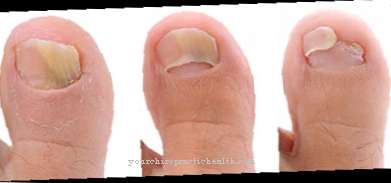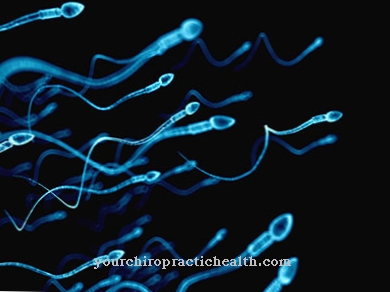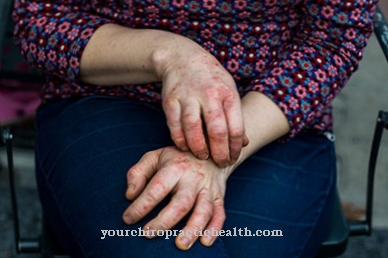Under the primary biliary cirrhosis a rare chronic liver disease is understood. At the present time it is called Primary biliary cholangitis known.
What is primary biliary cirrhosis?

© blueringmedia - stock.adobe.com
Primary biliary cirrhosis is the earlier name for a rare liver disease. Since the term "primary biliary cirrhosis" was viewed as misleading, the disease was renamed to Primary biliary cholangitis (PBC). The disease can often be diagnosed before cirrhosis of the liver develops.
Due to modern examination and therapy methods, around 66 percent of all patients no longer develop cirrhosis. In addition, those affected are often unsettled by the term “cirrhosis”. In 2014 and 2015, medical associations in Europe and America made the decision to adapt the new term "primary biliary cholangitis" to liver disease.
The WHO (World Health Organization) is now also reviewing a renaming. Primary biliary cirrhosis or primary biliary cholangitis primarily affects women. Around 90 percent of all sick people are female. The disease primarily affects the small bile ducts and then spreads to the entire liver tissue, which in turn can lead to its scarring.
However, cirrhosis of the liver does not appear until the end of the disease. The exact worldwide extent of primary biliary cirrhosis is unclear. In Germany, it is estimated that between 4,000 and 12,000 German citizens suffer from liver disease, which mainly manifests itself in the middle age between 40 and 60 years.
causes
Because antimitochondrial antibodies occur in more than 95 percent of all patients, medicine classifies primary biliary cirrhosis as an autoimmune disease. An autoimmune disease is when the body's own defense system is no longer able to differentiate between the body's own and foreign ones. In the case of PBC, the mitochondria in the body's own cells are attacked.
Autoantibodies are formed which are directed against the E2 subunit of the pyruvate dehydrogenase complex. This is the enzyme dihydrolipoyl transacetylase. However, it is still controversial whether other factors are also responsible for the onset of primary biliary cirrhosis.
Genetic and hormonal influences are discussed. The same applies to bacterial, viral or fungal infections, the use of certain drugs or environmental factors. It is also unclear what effects primary biliary cirrhosis has on pregnant women.
Symptoms, ailments & signs
Doctors divide primary biliary cirrhosis into four different stages. In stage I the epithelium of the bile ducts is destroyed, while in stage II there is a proliferation of the bile ducts. This leads to the development of pseudo bile ducts. Stage III is when there is fibrosis of the portal fields with necrosis and the bile ducts are increasingly disappearing.
In the fourth and final stage, liver cirrhosis finally appears and the organ takes on a greenish color. The symptoms of primary biliary cirrhosis begin gradually. About 70 to 90 percent of patients feel tired and exhausted. Itching, a disease of the thyroid gland such as Hashimoto's thyroiditis, dry mucous membranes, joint problems and symptoms similar to rheumatism are not uncommon.
Around 20 percent of all patients suffer from fat deposits in the inner corners of the eyes. Other possible complaints can be fatty stools and a lack of vitamins. Urinary tract infections are also not uncommon in female patients.In the late stage of primary biliary cirrhosis, typical cirrhosis complications such as esophageal varices, fundic varices, ascites (water belly), liver cancer and brain dysfunction occur.
Diagnosis & course of disease
If primary biliary cirrhosis is suspected, medical laboratory tests are carried out. Antimitochondrial antibodies (AMA) are present in the blood in more than 90 percent of all PBC patients. This finding alone can be considered evidence of the presence of primary biliary cirrhosis.
Furthermore, the general laboratory values are also above normal values and indicate inflammation or congestion of the biliary tract. If the laboratory tests do not provide precise evidence, a liver biopsy is carried out. The diagnosis can be confirmed by removing liver tissue.
In addition, it is important to differentiate primary biliary cirrhosis from other autoimmune diseases. In previous years, PBC patients had an average life expectancy of about twelve years. During this period, however, the disease was usually only discovered in its terminal stages.
Basically, the course of PBC proves to be very different from one individual to another. With a mild course of the disease there are usually only minor changes, while in other cases a faster course of the disease can be expected. In two out of three PBC patients, however, there is no longer any manifestation of life-threatening liver cirrhosis.
Complications
With this disease, those affected suffer from various liver problems. If this disease is not treated, it can, in the worst case, lead to the death of the patient. Because of this, this condition must definitely be treated by a doctor. Those affected primarily suffer from necrosis.
This disease also leads to cirrhosis of the liver and ultimately destruction of the liver. Those affected suffer from itching and also from jaundice. The mucous membranes dry out and the joints suffer from discomfort, so that the patients also suffer from restricted mobility. Without treatment, unpleasant side effects such as fatty stools and diseases of the urinary tract are favored.
In the worst case, liver cancer also occurs, which usually requires the organ to be transplanted. The earlier the disease is diagnosed, the better the chances of a complete cure. In severe cases, patients will have to rely on a liver transplant to continue to survive. The disease is treated with the help of drugs.
When should you go to the doctor?
Itching and skin changes indicate primary biliary cirrhosis and should be clarified as soon as possible by your family doctor or a dermatologist. In the further course of the disease, symptoms such as tiredness, joint problems or jaundice may appear, which must also be clarified by a doctor. If you have liver or spleen problems, it is best to consult a doctor directly. If there is cirrhosis of the liver, the emergency doctor must be called. Primary biliary cirrhosis occurs in 90 percent of cases in women.
It usually becomes noticeable between the ages of 40 and 60. A doctor should be consulted if these risk factors apply and the symptoms mentioned occur. Then it is best to see your family doctor or a specialist in internal medicine. Depending on the symptoms, specialists in liver diseases as well as gastroenterologists and dermatologists can also be consulted. The actual treatment takes place in a specialist clinic. Children should be presented to the pediatrician if the symptoms and symptoms mentioned occur.
Treatment & Therapy
Primary biliary cirrhosis is treated with ursodeoxycholic acid (UDC). The patient takes this as a tablet for the rest of his life. In the early stages of PBC, this drug can slow or stop the disease.
The benefit of immunosuppressants that were administered earlier is controversial. In most cases, however, they only make sense if there is an additional autoimmune hepatitis. If cirrhosis of the liver occurs despite treatment, a liver transplant may be required. With this comprehensive procedure, the PBC can be cured in 75 percent of all cases.
You can find your medication here
➔ Medicines for jaundice and liver problemsprevention
Prevention against primary biliary cirrhosis is not possible. The exact causes of the disease are still being researched.
Aftercare
Primary biliary cirrhosis requires regular follow-up examinations for constant monitoring by the doctor. The patients should absolutely keep the appointments, because the exact diagnosis is also an essential element in the follow-up treatment. In this way, a relapse can be detected early. The course of the disease can be precisely checked through the controls as part of the aftercare.
In accordance with the routine, check-ups every three to six months are recommended. If the laboratory values should worsen in the time after the actual therapy, further examination appointments are on the plan. Patients should not postpone the examinations, but rather consult the doctor in good time. Regardless of whether a liver transplant has taken place or not, it is essential for those affected to pay attention to other symptoms of the disease.
Increased tiredness and frequent itching indicate worsening. A regular daily rhythm helps to find a certain balance. Sufficient breaks and sleep phases must be observed so that the patient's condition improves. Long-term care is advisable after a liver transplant. This is available in the relevant transplant centers. In addition to the recommendations of the doctors, the mental support from family and friends is also very valuable for those affected.
You can do that yourself
Unfortunately, there is no therapeutic approach for this autoimmune disease that can cure the disease. The prescribed medication can not only alleviate the symptoms, but also delay the point in time for cirrhosis and thus for the necessary liver transplant. They should therefore be taken regularly. Medical checks should also be carried out regularly.
Due to the possible emotional problems that such a diagnosis can cause, accompanying psychotherapy is recommended, in which the fears and uncertainties that arise are discussed appropriately and can thus be overcome. Exchanging ideas with those who are also affected is also helpful. There is a liver self-help group and a patient group from the Erlangen Liver Center. Even a Facebook group for people with primary biliary cirrhosis now exists. Anyone who researches here on the Internet will quickly find it.
A reliably functioning immune system is also important in the case of an autoimmune disease. There are many ways to strengthen the immune system. Detoxification measures such as colon cleansing or purification cures complement dietary measures such as low-fat food that relieves the liver. Above all, animal fats should be avoided and high-quality omega-3-rich vegetable oils should be used instead. Omega-3 fatty acids are found in linseed oil or walnut oil, for example.
Furthermore, people with liver disease in particular should avoid stress. Instead, lots of sleep and rest, but also lots of exercise such as hiking, walking or swimming, are indicated.



























